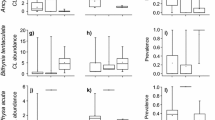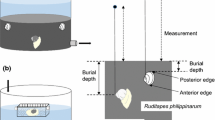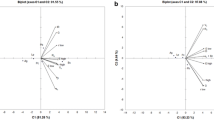Abstract
The glossiphoniid leeches Helobdella stagnalis and Glossiphonia complanata co-exist on the stony shores of British lakes. Because both species have a similar life-style and are food limited, the question arises as to how coexistence persists. Laboratory experiments investigated if either leech has a competitive advantage on three foods, viz. oligochaete worms (Tubifex sp.), snails (Lymnaea peregra), and a worm-plus-snail mixture. A variety of densities with a range of ratios of the two leeches, and monospecific controls were used. The level of feeding ensured increasing food shortage with rising leech density. Experiments, conducted at 14° C, lasted 3 months. Regression values for growth against density in the controls indicated the occurrence of intraspecific competition in both leech species. Light mortality occurred at the highest densities. G. complanata gained significantly less weight in mixed leech cultures than in monospecific cultures at some of the highest densities when fed worms, but more weight when fed on snails. The opposite was true for H. stagnalis. When both prey types were provided, no differences at any density were observed for either leech. Differences in bodysize and feeding strategy between the leeches may be implicated in determining their feeding success on the prey types. Because the anti-predatory responses (e.g. shaking) exhibited by L. peregra are less when encountering an inactive than an active leech, the sit-and-wait strategy of G. complanata may aid snail capture. In contrast, the seek-out strategy of H. stagnalis, coupled with its relatively smaller size, may result in fewer successful captures. The active hunting strategy of H. stagnalis may be advantageous for the capture of oligochaetes which are relatively less mobile than snails. Offering both prey types simultaneously would have had an ameliorating influence on interactions between the two leeches. Findings provide support for the hypothesis that long-term co-existence between the two glossiphoniids in British lakes may depend, in part at least, on the occurrence of a snail food refuge for G. complanata.
Similar content being viewed by others
References
Armitage MJ, Young JO (1991) Predators and planariid competitors of the triclad Phagocata vitta (Duges). Hydrobiologia 211: 43–50
Bronmark C, Malmqvist B (1986) Interactions between the leech Glossiphonia complanata and its gastropod prey. Oecologia 69: 268–276
Davies RW, Wrona FJ, Linton L (1979) A serological study of prey selection by Helobdella stagnalis (Hirudinoidea). J Anim Ecol 48: 181–194
Elliott JM, Mann KH (1979) A key to the British freshwater leeches. Freshwater Biol Assoc Sci Publ 40: 1–72
Law R, Watkinson AR (1987) Response-surface analysis of twospecies competition: An experiment on Phleum arenarium and Vulpa fasciculata. J Ecol 75: 871–886
Martin AJ (1992) Lake-dwelling leeches — coexistence and population regulation. Ph.D. Thesis, University of Liverpool
Reynoldson TB, Davies RW (1970) Food niche and co-existence in lake-dwelling triclads. J Anim Ecol 39: 599–617
Sawyer RT (1986) Leech biology and behaviour. Vols. 1 and 2. Clarendon Press, Oxford
Sigurjonsdottir H, Reynoldson TB (1977) An experimental study of competition between triclad species (Turbellaria) using the de Witmodel. Acta Zool Fenn 154: 89–104
Spelling SM, Young JO (1986a) The occurrence of metacercariae of the trematode, Cyathocotyle opaca (Wisniewski), in three species of lake-dwelling leeches. Freshwater Biol 16: 609–613
Spelling SM, Young JO (1986b) Seasonal occurrence of metacercariae of the trematode Cotylurus cornutus (Szidat) in three species of lake-dwelling leeches. J Parasitol 72: 837–845
Spelling SM, Young JO (1986c) The population dynamics of metacercariae of Apatemon gracilis (Trematoda: Digenea) in three species of lake-dwelling leeches. Parasitology 93: 517–530
Spelling SM, Young JO (1987) Predation on lake-dwelling leeches (Annelida; Hirudinea): an evaluation by field experiment. J Anim Ecol 56: 131–146
Townsend CR, McCarthy TK (1980) On the defence strategy of Physa fontinalis (L.) a freshwater pulmonate snail. Oecologia 46: 75–79
Watkinson AR (1981) Interference in pure and mixed populations of Agrostemma githago. J Appl Ecol 18: 967–976
Wit CT de (1961) Space relationships within populations of one or more species. In: Milthorpe FL (ed) Mechanisms in biological competition. Symp Soc Exp Biol 15: 314–329
Wit CT de (1972) On the modelling of competitive phenomena. In: Boer PJ de, Gradwell GR (eds) Dynamics of populations. Centre Agric Publ Docum, Wagenigen
Wrona FJ, Davies RW, Linton L (1979) Analysis of the food niche of Glossiphonia complanata (Hirudinoidea: Glossiphoniidae). Can J Zool 57: 2136–2142
Wrona FJ, Davies RW, Linton L, Wilkialis J (1981) Competition and coexistence between Glossiphonia complanata and Helobdella stagnalis (Glossiphoniidae: Hirudinoidea). Oecologia 48: 133–137
Young JO (1980) A serological study of the diet of Helobdella stagnalis (Hirudinea: Glossiphoniidae) in British lakes. J Zool London 192: 467–488
Young JO (1981a) A serological study of the diet of British lake-dwelling Glossiphonia complanata (L.) (Hirudinea: Glossiphoniidae). J Nat Hist 15: 475–489
Young JO (1981b) A comparative study of the food niches of lakedwelling triclads and leeches. Dev Hydrobiol 6: 91–102
Young JO, Ironmonger JW (1980) A laboratory study of the food of three species of leeches occurring in British lakes. Hydrobiologia 68: 209–215
Young JO, Ironmonger JW (1981) A quantitative study of the comparative distribution of non-parasitic leeches and triclads in the stony littoral of British lakes. Int Rev Ges Hydrobiol 60: 847–862
Young JO, Ironmonger JW (1982a) A comparative study of the life histories of three species of leeches in two British lakes of different trophic status. Arch Hydrobiol 94: 218–250
Young JO, Ironmonger JW (1982b) The influence of temperature on the life cycle and occurrence of three species of lake dwelling leeches (Annelida: Hirudinea). J Zool London 196: 519–543
Young JO, Procter RM (1985) Oligochaetes as a food resource of lake-dwelling leeches. J Freshwat Ecol 3: 181–187
Young JO, Procter RM (1986) Are the lake-dwelling leeches, Glossiphonia complanata (L.) and Helobdella stagnalis (L.), opportunistic predators on molluses and do they partition this food resource? Freshwater Biol 16: 561–566
Young JO, Spelling SM (1986) The incidence of predation on lake-dwelling leeches. Freshwater Biol 16: 465–477
Young JO, Spelling SM (1989) Food utilization and niche overlap in three species of lake-dwelling leeches (Hirudinea). J Zool London 219: 231–243
Zar JH (1984) Biostatistical Analysis. Prentice-Hall, New York
Author information
Authors and Affiliations
Rights and permissions
About this article
Cite this article
Young, J.O., Martin, A.J. & Seaby, R.M.H. Competitive interactions between the lake-dwelling leeches Glossiphonia complanata and Helobdella stagnalis: an experimental investigation of the significance of a food refuge. Oecologia 93, 156–161 (1993). https://doi.org/10.1007/BF00317664
Received:
Accepted:
Issue Date:
DOI: https://doi.org/10.1007/BF00317664




